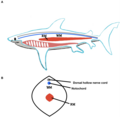Welcome to the shark portal

Sharks are a group of elasmobranch fish characterized by a cartilaginous skeleton, five to seven gill slits on the sides of the head, and pectoral fins that are not fused to the head. Modern sharks are classified within the clade Selachimorpha (or Selachii) and are the sister group to the Batoidea (rays and kin). Some sources extend the term "shark" as an informal category including extinct members of Chondrichthyes (cartilaginous fish) with a shark-like morphology, such as hybodonts. Shark-like chondrichthyans such as Cladoselache and Doliodus first appeared in the Devonian Period (419–359 million years), though some fossilized chondrichthyan-like scales are as old as the Late Ordovician (458–444 million years ago). The oldest confirmed modern sharks (selachimorphs) are known from the Early Jurassic, about 200 million years ago, though records of true sharks may extend back as far as the Permian.
Sharks range in size from the small dwarf lanternshark (Etmopterus perryi), a deep sea species that is only 17 centimetres (6.7 in) in length, to the whale shark (Rhincodon typus), the largest fish in the world, which reaches approximately 12 metres (40 ft) in length. They are found in all seas and are common to depths up to 2,000 metres (6,600 ft). They generally do not live in freshwater, although there are a few known exceptions, such as the bull shark and the river shark, which can be found in both seawater and freshwater. Sharks have a covering of dermal denticles that protects their skin from damage and parasites in addition to improving their fluid dynamics. They have numerous sets of replaceable teeth.
Several species are apex predators, which are organisms that are at the top of their food chain. Select examples include the tiger shark, blue shark, great white shark, mako shark, thresher shark, and hammerhead shark. (Full article...)
Selected article -
Grey reef sharks are fast-swimming, agile predators that feed primarily on free-swimming bony fishes and cephalopods. Their aggressive demeanor enables them to dominate many other shark species on the reef, despite their moderate size. Many grey reef sharks have a home range on a specific area of the reef, to which they will return time and again. However, they are not territorial but rather quite social. During the day, these sharks often form aggregations of 5–20 individuals near coral reef drop-offs, and then split up in the evening as the sharks begin to hunt. Adult female grey reef sharks also form groups in very shallow water, where the higher water temperature may accelerate their growth or that of their unborn young. Like other members of its family, the grey reef shark is viviparous, meaning that the mother nourishes her embryos through a placental connection. Litters of 1–6 pups are born every other year.
Grey reef sharks were the first shark species known to perform a threat display, a stereotyped behavior warning that it is prepared to attack. The display involves a "hunched" posture with characteristically dropped pectoral fins, and an exaggerated, side-to-side swimming motion. Grey reef sharks will often perform the display if they are followed or cornered by divers to indicate that they perceive a threat. This species has been responsible for a number of attacks on humans and should be treated with caution, especially if they begin to display. Grey reef sharks are caught by many fisheries and are susceptible to local population depletion due to their low reproductive rate and limited dispersal. As a result, the World Conservation Union has assessed this species as Near Threatened.
Did you know (auto-generated)

- ... that Hixxy and Sharkey created a schism in the UK rave music scene in 1995?
- ... that Alexis Sharkey's last Instagram post before her murder documented her travels to Tulum, Mexico?
- ... that the ampullae of Lorenzini enable sharks to sense electric fields?
- ... that "the Hurricane Shark is real"?
- ... that since 2018, IKEA's stuffed toy shark Blåhaj has become a popular Internet meme and an icon of the online transgender community?
- ... that Timo Meier became the first player in San Jose Sharks franchise history to score five goals in one game when he was 25?
Categories
Related portals
WikiProjects
Selected picture -

More Did you know? -
- ... that the zebra shark is striped when young and spotted when mature?
- ... that the blurred and smooth lanternsharks form a species group distinguished from the rest of their family by the shape and arrangement of their dermal denticles?
- ... that the leopard shark feeds on anchovies by swimming into their schools with its mouth open and waiting for them to accidentally enter?
- ... that relative to its body size, the horn shark has the strongest known bite of any shark?
- ... that the title for Peter Benchley's best-selling 1974 novel Jaws was not agreed until 20 minutes before it went into production?
General images
Topics
For additional lists of marine life-related featured articles and good articles see:
Wikimedia
The following Wikimedia Foundation sister projects provide more on this subject:
-
Commons
Free media repository -
Wikibooks
Free textbooks and manuals -
Wikidata
Free knowledge base -
Wikinews
Free-content news -
Wikiquote
Collection of quotations -
Wikisource
Free-content library -
Wikispecies
Directory of species -
Wikiversity
Free learning tools -
Wiktionary
Dictionary and thesaurus














































